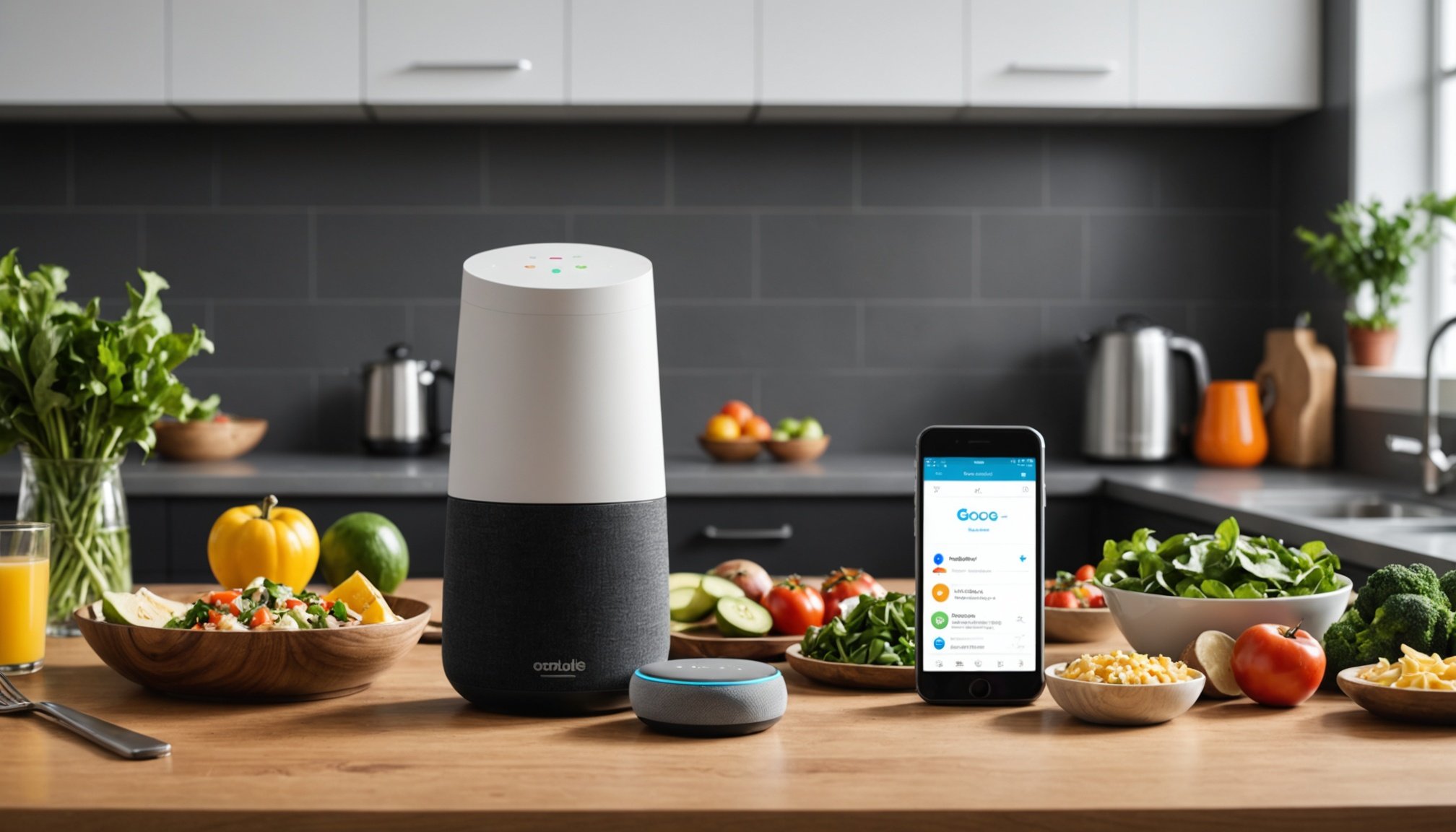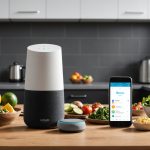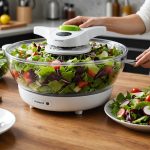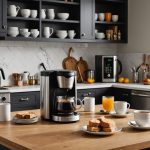Overview of Smart Kitchen Innovations
In today’s digital age, smart kitchen innovations are revolutionizing how we approach cooking. These technological advancements streamline everyday tasks and elevate the culinary experience. Key components of this shift include meal planning technology and digital assistants, like Alexa and Google Home, which play a pivotal role in transforming kitchen practices.
Digital assistants act as personal chefs, guiding users through meal preparation while considering dietary preferences and restrictions. With a simple voice command, these intelligent systems manage grocery lists, suggest creative recipes, and even track nutritional information, ensuring a healthy lifestyle. Innovations in meal planning technology are driving efficiency, helping families eat healthier, and saving valuable time.
This might interest you : Key design features of salad spinners to maximize freshness and elevate your salad experience
Current trends indicate an increasing adoption of these technologies, as more households recognize the benefits of integrating such systems into their daily routines. Smart kitchen innovations not only offer convenience but also empower users to be more adventurous and health-conscious with their cooking choices. From seasoned cooks to beginners, the digital capabilities of Alexa and Google Home continue to captivate users, promising yet more advancements in enriching the modern kitchen experience.
Benefits of Using Alexa and Google Home for Meal Planning
Smart assistants like Alexa and Google Home offer remarkable benefits for meal planning, especially in our fast-paced lives. One of the most significant advantages is the time-saving feature provided by these voice-activated systems. With just a few simple commands, users can effectively plan their weekly meals, minimizing time spent on planning and preparation.
Also to discover : Revitalize your kitchen: pro tips for creating a chic slimming tea and coffee corner
These devices also encourage healthier eating habits by allowing users to track dietary preferences and nutritional intake. By providing instant access to nutritional information, these assistants help users make informed healthier food choices, ensuring balanced diets. Additionally, they offer customized recipe suggestions that fit specific dietary needs, promoting a consistent healthy lifestyle.
The convenience these smart assistants bring, extends to grocery shopping as well. They streamline the entire process by simplifying grocery list management, making sure that users never miss any essential items. The ability to handle meal prep and manage grocery shopping through integrated systems significantly enhances efficiency and reduces daily stress. With such cooking convenience, Alexa and Google Home empower individuals to navigate the complexities of meal planning, transforming routine cooking into an enjoyable, stress-free experience.
Setting Up Alexa and Google Home for Meal Planning
The smart home setup process is crucial in utilizing Alexa and Google Home for meal planning. First, ensure your digital assistants are in an optimal location within your kitchen, providing seamless voice recognition. The setup requirements typically involve connecting the devices to a reliable Wi-Fi network and downloading the respective apps on your smartphone.
Device setup requirements
Both Alexa and Google Home require a compatible smartphone for the initial setup. Make sure to update your smart assistants’ apps to the latest version to access all features. Connect the devices to a stable Wi-Fi network for uninterrupted operation.
Installing meal planning skills and apps
Numerous apps and skills are available for installing meal planning capabilities. Search within the app stores for compatible applications, such as meal planners, recipe organizers, or dietary trackers, and follow instructions to link them with your digital assistant.
Customizing settings for personalized meal suggestions
Customizing settings is fundamental for receiving personalized meal ideas. Adjust preferences by providing information about dietary restrictions and using voice commands to store favourite ingredients and recipes. Tailoring your smart home setup ensures the virtual kitchen assistant aligns perfectly with your daily culinary routine.
Using Smart Devices for Grocery List Management
The effectiveness of grocery list tools in smart devices is transforming household shopping. Modern systems, such as Alexa and Google Home, allow users to effortlessly create and manage grocery lists via simple voice commands. This capability enhances user experience by automating often-tedious tasks.
Smart shopping is further enhanced by the ability to sync grocery lists with family members in real time. This ensures all household members are updated, regardless of who initiates a shopping trip. Such synchronization optimizes time and reduces duplication of purchases.
Smart devices also offer tips for shopping optimization, helping users find deals and discounts. Through intuitive voice interactions, users can ask for insights regarding promotions or cost-effective alternatives. This fosters budget-friendly shopping habits and allows families to allocate resources more effectively.
Using these technologies to link lists to online grocery services can simplify ordering processes, delivering convenience straight to your doorstep. By embracing digital innovation in the kitchen, users are empowered to streamline shopping experiences, modify lists dynamically, and maintain control over their grocery needs, all while ensuring innovation in routine chores. This defines why smart devices continue to be a strategic asset for diligent shoppers.
Innovative Recipe Suggestions with Smart Assistants
Smart assistants like Alexa and Google Home offer a treasure trove of recipe discovery at your fingertips. With a simple command, users gain access to thousands of culinary creations, catering to both novice and seasoned cooks. These meal ideas can be tailored to what’s already in your pantry, minimizing waste and optimizing resources.
Accessing thousands of recipes through voice assistants
Voice-activated functionality enables instant retrieval of diverse healthy cooking recipes. Whether searching for a low-carb dinner or a vegan dessert, these devices provide swift recommendations, enhancing cooking creativity and convenience.
Meal recommendations based on what’s in your pantry
Smart assistants offer meal ideas by analyzing available ingredients, suggesting delicious concoctions without requiring additional shopping trips. This feature promotes efficient use of resources while encouraging inventive cooking.
Filter options for dietary restrictions and preferences
Utilizing smart kitchen innovations means effortless customization of recipes. Users can filter options based on dietary needs like gluten-free or keto diets, ensuring meal choices align with health goals. By interacting with Alexa and Google Home, users can adjust serving sizes, cooking times, and preferences to suit their family’s dining requirements. Such adaptability fosters a healthier, more personalized culinary experience.
Nutritional Guidance and Healthy Eating Tips
Smart kitchen innovations provide a plethora of options to aid in maintaining healthier eating habits. Digital assistants like Alexa and Google Home offer real-time nutritional advice, making it easier to adhere to dietary guidelines. Users can gain invaluable insights through smart devices by simply asking questions related to nutritional facts and desired health outcomes.
Tracking nutritional information is simplified, enabling users to monitor their meals meticulously. Smart devices assist in portion control by offering tailored guidance based on individual’s goals. Moreover, users can receive suggestions for healthier ingredient choices to optimize nutritional value.
For those aiming to watch their calorie or nutrient intake, these technologies deliver efficient solutions. Integrated meal planning technology features allow users to log and track calorie consumption, offering insights that empower better decision-making. Such options foster a balanced diet by providing an overview of dietary intake over time.
The convenience of voice-enabled technology encourages sustainable healthy eating habits. By harnessing smart kitchen innovations, individuals are well-equipped to pursue health-conscious living with efficiency, ensuring dietary practices align ideally with recommended guidelines. Through these cutting-edge capabilities, everyone can enhance their lifestyle with informed culinary choices.
User Reviews and Comparisons of Smart Kitchen Devices
Smart kitchen innovations continue to captivate with features that simplify and enrich meal planning experiences. When comparing Alexa and Google Home in the smart kitchen domain, their robust functionalities provide ease and efficiency. Users frequently highlight the strengths and weaknesses observed through firsthand usage.
Overview of Popular Devices in the Smart Kitchen Market
Devices comparisons are crucial in evaluating which smart assistant best fits one’s culinary needs. Alexa impresses with extensive recipe discovery capabilities, while Google Home integrates seamlessly with other Google services.
User Experiences with Alexa and Google Home for Meal Planning
User feedback often points to Alexa’s skill in providing creative meal ideas as a standout attribute. Google Home users appreciate the device’s ability to employ precise voice commands, which enhances healthy cooking recipes access.
Pros and Cons of Using Different Smart Kitchen Devices
Both digital assistants boast strengths, yet user testimonials suggest variance in cooking convenience. Alexa excels in user-defined skill customization, whereas Google Home is praised for its intuitive conversational abilities. Determining the right fit often relies on individual preferences and dietary requirements. Such reviews are pivotal for prospective adopters seeking insight before investing in smart kitchen technology.
Success Stories: Transforming Meal Planning with Technology
Incorporating smart assistants in daily routines has shown significant health transformations for many users. Real-life user testimonials reveal how Alexa and Google Home have revolutionized their approach to meal planning. One remarkable example is Lucy from Manchester, who improved her health by streamlining her dietary habits with these devices.
By creating dynamic grocery lists and receiving customized meal ideas, she achieved her wellness goals. These case studies showcase the practical impact of smart technology. Users share lessons on efficient management, emphasizing the importance of setting up personalized recommendations. For instance, Mark from London highlights the ease of maintaining a balanced diet by leveraging voice-activated tools to track nutritional intake.
Such case studies demonstrate not only technological success but also the profound influence on lifestyle adaptations. Increased awareness and seamless integration make adhering to dietary guidelines simpler and more effective. Many individuals report reduced stress and enhanced creativity in cooking, as digital assistants facilitate meal preparation based on seasonal ingredients and personal preferences. These transformative experiences underscore the tangible benefits of embracing innovative meal planning technologies for overall well-being.











